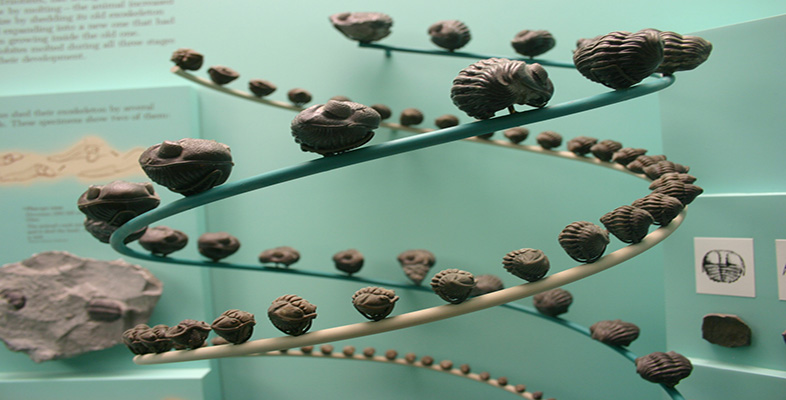1 The Cambrian explosion
1.1 A burst of evolution
One of the most important events in the history of life began about 545 million years (Ma) ago, i.e. some four billion years after the origin of the Earth, and over 3.3 billion years after the origin of life. The term 'Cambrian explosion' reflects a sudden burst of evolution, when a wide variety of organisms, especially those with hard, mineralised parts, first appear in the fossil record. Thus began the Phanerozoic Eon - 'the time of visible life' - and the Palaeozoic Era.
As part of this course you will often be referred to a pdf file taken from Douglas Palmer's Atlas of the Prehistoric World.
Before going any further, click on 'View document' below and read pages 58-61 from Douglas Palmer's Atlas of the Prehistoric World.
View document [Tip: hold Ctrl and click a link to open it in a new tab. (Hide tip)]
At the start of the Cambrian Period, body fossils with hard shelly parts became abundant for the first time. Actually, the very first evidence of preservable hard parts comes from some tiny fossils, including tubes made of calcium carbonate about 0.2 mm across, found in late Precambrian strata about 550 Ma old. The unknown organisms that produced them were living at the same time as the Ediacaran fauna.
SAQ 1
What, in general, was different about the size of fossils with hard shelly parts in the earliest Cambrian, compared with late Precambrian life such as the Ediacaran organisms?
Answer
The fossils with hard shelly parts were much smaller (Atlas, p. 60).
A wide variety of small (1-2 mm) shelly fossils appeared in the earliest part of the Cambrian Period - assorted shapes such as tubes and cones, as well as spines, scales, and knobs (Atlas, pp. 58-59). It's often difficult to tell whether a fossil is the complete skeleton of a single organism or an isolated part of some larger creature. The soft tissues associated with these hard parts are almost entirely unknown, and the reconstructions of soft parts shown in the Atlas (pp. 60-61) are conjectural.
SAQ 2
What seems likely to have been the main stimulus for the acquisition of hard parts by organisms in the earliest Cambrian?
Answer
The need for protection (Atlas, pp. 60-61).
Protection from predation or other damage is certainly consistent with the first appearance of defensive structures such as spines and scales, and tubes and conical shells that could protect vulnerable soft parts inside. There are, however, a number of other possible reasons why hard parts first evolved, as discussed in the Atlas, p. 61, some or all of which may have been involved.
SAQ 3
A greatly increased variety of types of trace fossils, especially burrows of soft-bodied animals, are found around the start of the Cambrian Period. What is the significance of this finding?
Answer
It reflects the evolution of more complex patterns of activity and behaviour, some of it probably related to the avoidance of predators.
Although environmental changes were occurring (such as a rise in global sea level (Atlas, p. 58), there is, to date, little evidence of special, widespread environmental changes that could have directly triggered the Cambrian explosion. Whatever the causes, once triggered, a wide range of ecological opportunities presumably became available for exploitation, promoting the rapid evolution of new, quite different types of animals. By about 530 Ma, most of the animal phyla that are in existence today had appeared. Not surprisingly, a few entirely soft-bodied phyla living today have no known fossil record, so we don't know when they evolved. Evidence from genetics suggests that some animal phyla had diverged from each other much earlier than the start of the Cambrian explosion, but the timing remains uncertain.
Many of the newly evolved Cambrian phyla show organisation of the body into specialised areas - especially a head end with food-trapping and sensory organs, a tubular gut and limbs. There is no doubt that many Cambrian animals were equipped with adaptations for preying on other animals, and were able to pursue food much more actively than could the Ediacaran fauna - such as by scuttling over the sea floor, swimming actively, and burrowing. Note that all forms of life (except possibly a few algae) were as yet confined to the sea.
Although many types of the small shelly fossils disappear from the fossil record soon after the start of the Cambrian, some are thought to have been molluscs at an early evolutionary stage, in which case they did leave descendants.
